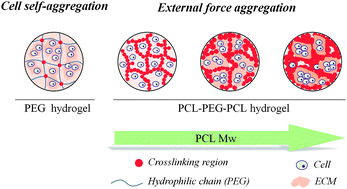Cartilage formation through alterations of amphiphilicity of poly(ethylene glycol)–poly(caprolactone) copolymer hydrogels
Abstract
Hydrogels are of interest as scaffolds for cartilaginous tissue engineering due to their biocompatibility, swelling ratio, mechanical strength, and degradative behavior. This study was conducted to establish the most suitable poly(ε-caprolactone)–poly(ethylene glycol)–poly(ε-caprolactone) (PCL–PEG–PCL) triblock copolymer hydrogel for the optimal proliferation and differentiation of encapsulated chondrocytes for cartilage regeneration. PEG was copolymerized with PCL and then acrylated to confer photocrosslinking capacity. Chondrocytes were encapsulated within photocrosslinked triblock PEG-co-PCL hydrogels prepared with varying compositions. The effects of composition on the hydrogel properties and behavior of embedded cells were studied by varying the molecular weights, and thus the segment length, of the PEG and PCL blocks. Hydrogels with high-molecular-weight (10 000 Da) PEG were associated with higher swelling ratios (9.6 ± 0.2) and a reduced elastic modulus (0.223 ± 0.007 N mm−2). Biochemical analysis indicated a positive correlation between the swelling ratio and expression levels of glycosaminoglycans and total collagen. There was a 1.8-fold increase in glycosaminoglycan and 2.4-fold increase in total collagen content in hydrogels with the highest-molecular-weight (10 000 Da) PEG when compared to hydrogels with the low-molecular-weight (2000 Da) PEG after four weeks of culture. Histological examinations revealed more extensive collagen type II secretion and accumulation around chondrocytes when the molecular weight of the hydrophobic PCL segment increased. The lengths of the hydrophobic (PCL) and hydrophilic (PEG) segments resulted in changes in the properties of hydrogels that improved cellular proliferation and the production and distribution of extracellular matrix for cartilage regeneration.


 Please wait while we load your content...
Please wait while we load your content...